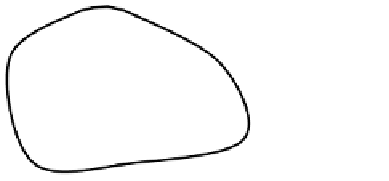Biomedical Engineering Reference
In-Depth Information
I
Stim
i
R
m
C
m
I
ion
I
Cm
E
rest
e
Figure 2.8:
Passive membrane circuit analog with a resting potential.
2.4.7 The Goldman-Hodgkin-Katz Equation
In reality, there are many ions with different abilities to cross the membrane. There are also some large
charged particles (e.g., proteins) that cannot cross the membrane. The result is that achieving
I
ion
=
0
to calculate
V
res
m
is somewhat more difficult. We will not provide a derivation here but as the major ions
involved are Sodium, Potassium, and Chloride,
V
rest
m
can be approximated by the Goldman-Hodgkin-
Katz equation:
ln
P
K
[
K
+
]
e
+
Na
+
]
e
+
Cl
−
]
i
RT
F
P
Na
[
P
Cl
[
E
m
=
(2.37)
K
+
]
i
+
Na
+
]
i
+
Cl
−
]
e
P
K
[
P
Na
[
P
Cl
[
where the
P
-terms are the relative
permeabilities
(unitless) of the respective ions.
Na
+
=14mM
K
+
=140mM
Na
+
=142mM
K
+
=4mM
Figure 2.9:
Multiple ions species and the Goldman-Hodgkin-Katz equation.
Figure 2.9 shows a simple example for only
Na
+
and
K
+
ions when the cell is at rest. Given that
J
96487
mol
,
P
K
=
1,
P
Na
=
0
.
002,
R
=
8
.
316
K
mol
,
T
=
300
K
, and
F
=
RT
F
0
.
0258
J
=
C
=
25
.
8
mV
(2.38)



























